Counterpressing variations
The buzzword in tactics in the Bundesliga last season was probably gegenpressing (counter pressing).Dortmund were champions thanks to their counter pressing, but Bayern have moved up and are now currently unchallenged at the top of the table. FC Barcelona under Pep Guardiola won the Champions League twice with an outstanding use of Angriffspressing and counter pressing. But is all counter pressing the same?
Distinction no. 1: Preparing the counter pressing
Counter pressing includes not only the movement of the team to the ball, but also their previous positions and positioning. It is also true to an extent that counter pressing has a mental aspect. If a player switches off after losing possession and there is no immediate effort to win back the ball, then the opportunity for counter pressing is lost.
A player would either have to have the temperament to immediately attack the ball or develop the attitude thru drills. Normally, it is a combination of training, mind, and character.
But the tactics also plays a role. A team may quickly switch after losing the ball and work hard to win back the ball, but counter pressing will only be successful if the previous position of each player is correct. An extremely wide formation with numerical overloads will be ineffective in counter pressing but an offensively compact formation with isolated narrowness will not.
The trainer can decide in advance where the team should be narrow and where they should be wide. For example, this can be adjusted to a specific interest in the opponent’s strengths in certain areas or to the team’s own weaknesses, i.e. a risky offensive player or complex moves.
Where do I want the team to be narrower and more compact in order to create the best possible counter pressure?
Distinction no. 2: Zonal marking in counter pressing
In the counter pressing process, as an end to itself, one can make some distinctions. The big question is: how does a team base its reference points?
These are not the same reference points as in zonal marking or classic pressure. When counter pressing you stand in a highly shifted, crazy formation and press directly against the ball. The question is: how do you win back the ball? There are four major variants here.
Leeway-oriented counter pressing :
Dortmund’s counter pressing falls into this category.
It is based heavily on the available space of the opponent. The opponent will be cut off, pressed, and ideally have no room to breathe. All sorts of running and passing lanes are blocked or deliberately left open, which is usually a result of the trainer’s aforementioned preparation of the team’s positioning.
By playing this way one can steer their opponents outside and overtake them by counter pressing the ball or, due to the cutoff space, move closer and closer and win the ball back classically.
The left-back of the red team runs past his opponent and plays the ball into the middle. The indented left winger of the red team gets the ball, turns, and loses it to the opposing right-back.
The opponent with the ball is then immediately pressed and the red team automatically slide into space. They realize that the opponent has two spaces and they don’t occupy them, but base their positions on them. A nice side effect is created: the opponent will often play the pass and be intercepted if he is inaccurate, but, if the opponent delays his decision-making, the team has more time to move towards him and achieve greater narrowness.
Access-oriented counter pressing :
Bayern’s counter pressing is the most likely to fall into this category.
In most cases, the opposing ball carrier is not pressed by the entire team but by one or two nearby players, while the others are not fixed to their positions, but take on the nearest opponent in a kind of man coverage. This brief situational man orientation ensures that after the enemy passes the players can always obtain access and challenge for the ball. The pressure on the ball carrier isn’t extreme, but should be enough to push him back or force him into immediate action.
While the nearest player, in this case the player who lost the ball, presses, the red team players move in the direction of their opponents and become man-oriented. In this case, the pass is easier to play, but it leads to many challenges and the opponent may often be doubled. There are no 50-50 balls, but there is an advantage for the red team because of their movement and the structure of their attack.
Passing lane-oriented counter pressing :
Since Pep Guardiola’s hire, FC Barcelona have played with a more anticipatory counter pressing that is primarily oriented towards the passing lanes.
The surrounding players push towards the ball carrier so that they open up specific passing lanes to him and block off others. It’s not so much about reducing space or challenging for the ball, but rather provoking deliberate passes into supposedly open space and then intercepting them. This is done by channeling passes into strategically unfavorable directions (for example, diagonally to the outside in a shorthanded situation) or in that space, e.g. where Sergio Busquets is covering.
They move – ideally – a little bit later or make their approaches arc-like, but can then intercept the passes. Alternatively, they use their cover shadows and prevent the opponent making simple passes. They cut them off and provoke long balls or back passes, which creates a “normal” pressing out of the counter pressing in the classic sense.
Ball-oriented counter pressing :
The first team that used a collective counter pressing may have been the Dutch at the 1974 World Cup.
It was a chaotic counter pressing in some ways, because the players themselves were all heavily focused on the ball carrier and not his options. At the time, this was probably the better choice because the individual players were not trained in the small battles for the ball and the opposing players were not organized after recovering the ball or trained to resist pressure.
In this case all of the surrounding players move to the ball and press. This opens the potential pass to the player in the middle, who will then be pressed. If the defender is not excellent in ball handling, then this option is destroyed by pushing up and exerting greater pressure on the ball carrier.
Statistics
I was interested whether the different counter pressing variants would be visible in the statistics. My hypothesis was as follows: Bayern would have to be excellent in challenges with their access-oriented style, but weaker in Pressingkompetenz because they have fewer interceptions. BVB would, in turn, be weaker at tackling, but have better Pressingkompetenz, while FC Barcelona would be the opposite of Bayern.
The numbers fit. I have calculated the average values of the three central midfielders of the respective teams. When counter pressing one would have to distinguish them from each other the most, because they are the main beneficiaries. The full-backs are usually too wide or too deep, the strikers are the “pressers” and those who post the lost ball, while the midfielders either intercept the ball or challenge for it. For graphical reasons, I’ve also multiplied the values by 100.
Hardly surprising: Gundogan and Co. are stronger than Busquets and partners in direct challenges, while Bayern are clearly the strongest. I attribute this unique superiority to, among other things, good counter pressing and access orientation. Bayern not only tackle more often but are better at it. The Catalans, however, tackle extremely rarely and often in more awkward locations.
In the Pressingkompetenz statistic it is easy to see the advantage of FC Barcelona’s pressing style.
With 174.37, they are at the top by a wide margin, while Dortmund finish second with 86.10. What is striking here is that Bayern, despite their excellent defense, are so far behind. This is easily explained by their contrasting style: Munich collect fewer loose balls, break up fewer passes and instead win the ball via provoked challenges. At the same time, the stability of the defense is greater and the quality chances for the opponent are reduced, if he can extricate himself from the counter pressing.
What else?
Not much. The transitions are fluid, because the respective teams and especially the players will naturally adjust and adapt situationally; it’s more about having a general orientation for the players’ actions. Also, counter pressing should not be confused with “normal” pressing as unfortunately happens so often. Counter pressing is the direct and immediate effort to win the ball back after it is lost, while pressing is the fundamental work to get back the ball by moving out of or within the formation.
Written by RM (in 2012, so it’s about Heynckes’ Bayern)
Translated by @rafamufc
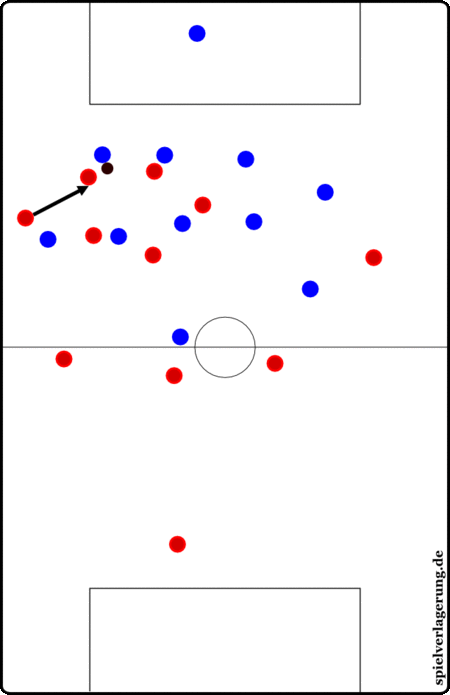
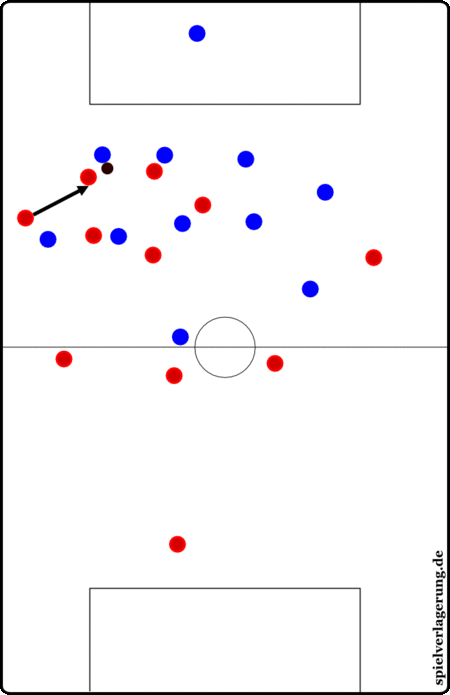
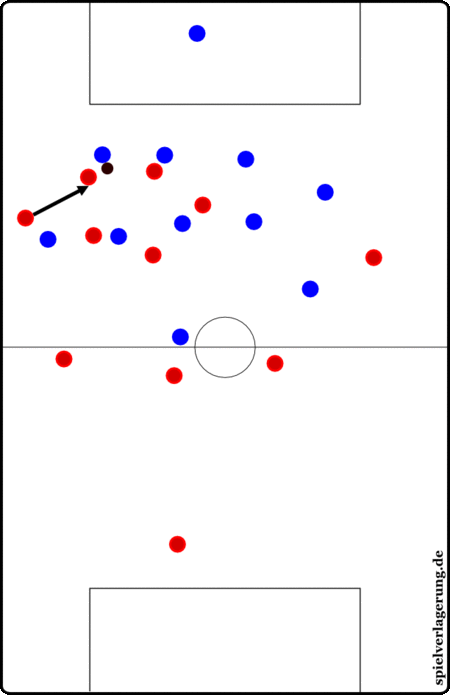
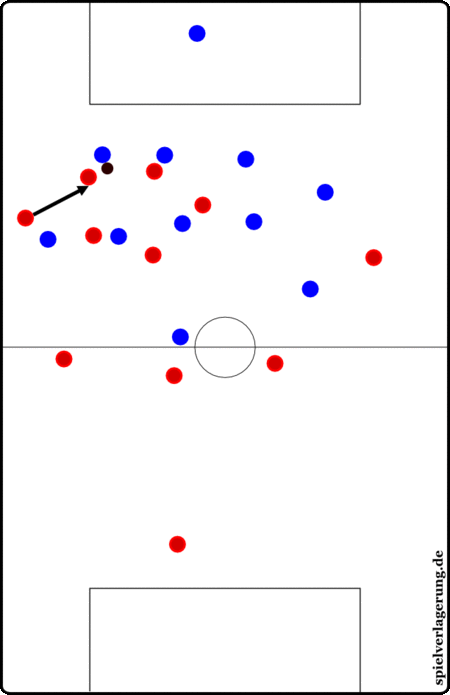
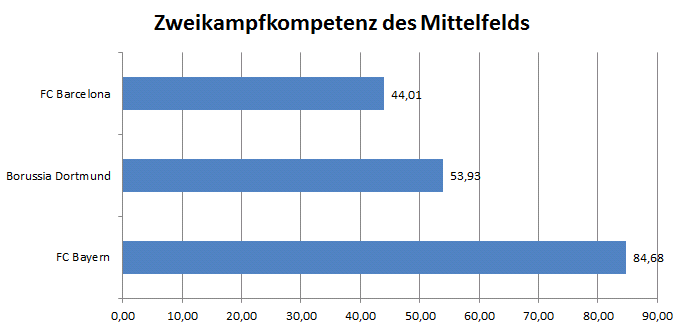
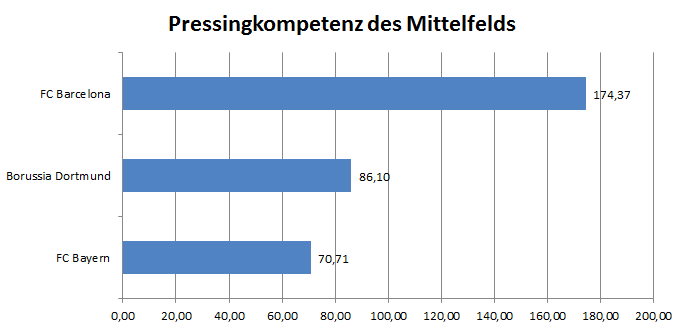
2 Kommentare Alle anzeigen
simon August 16, 2014 um 9:29 am
Hi great article I.ve really enjoyed your articles on both pressing and zonal and man marking. What would also be interesting would be how offenses try and break down differetn types of defense.
@rafamufc July 7, 2014 um 9:05 pm
Just a footnote for readers regarding leeway-oriented counter pressing. Leeway, in this instance, refers to the available space for a player to play. The definition of leeway is “the amount of freedom to move or act that is available.”
I realize this is a rather uncommon word but it really fits the intended translation quite well, imho.